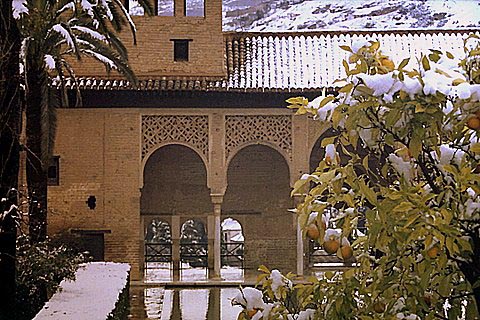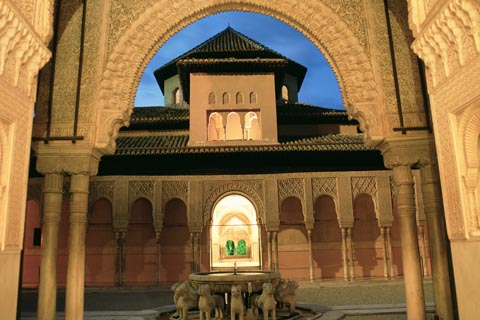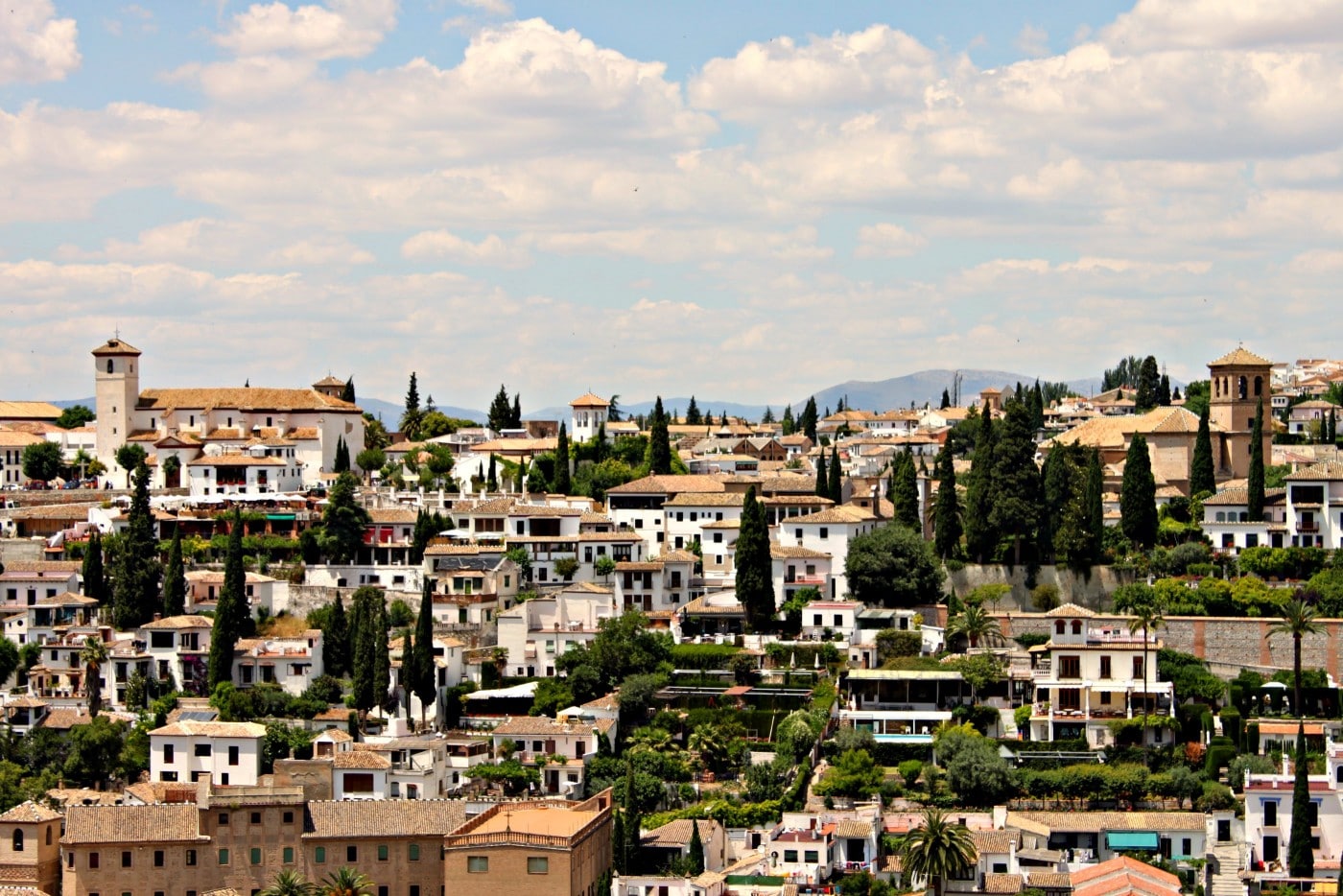Much More than the Alhambra

Situated on the rugged foothills of the Sierra Nevada, Granada has long been famed as the site of the Alhambra, the glorious 14th-century palace built under Moorish rule. But in recent years, ambitious efforts by the Andalusian Legacy Foundation to revive Granada’s rich Hispanic-Moorish past have made many other areas of the city wonderfully inviting.
The revival is most noticeable in the Albaicín quarter, which was built on a hill around a citadel founded in the 11th century. In a maze of cobblestone streets and whitewashed homes with hidden inner patios, chic hotels have opened in carefully restored medieval buildings, and new restaurants serve a delicious mix of Middle Eastern fare and traditional Andalusian cuisine.
You could spend at least two days in the Albaicín. But before beginning a climb or bus ride to the top, stop at the Moroccan tea and spice shops and bazaars around the Plaza Nueva, at the base of the hill. They feature handcrafted jewelry, brass tea sets and colorful paper lanterns, popular items with tourists and residents, including many of the 60,000 students who attend the city’s ancient university. At dusk, people flock to the Mirador of San Nicolás, a park near the quarter’s high point, to watch the sunset over the Alhambra. Afterward, you have a choice of several pretty garden restaurants nearby. As the night progresses, flamenco, American pop, Arabic chants and even reggae pours from intimate clubs and floods the streets surrounding Plaza Nueva and the historic center.
Start your tour of the Albaicín with a visit to the Bañuelo, Carrera del Darro, 11th-century Moorish baths, where people once held meetings over haircuts and massages. Though no longer functional, they have been restored to their original classical symmetry. In the Archaeological Museum, Carrera del Darro you will find a splendid collection of pottery, jewelry and architectural fragments from prehistoric to Phoenician and Iberian times. Near Calle Calderería Nueva, you could stop at a cozy Moroccan tearoom – called teterías – for a variety of herb, spice and fruit teas, as well as batidos, delicious blends of milk with fruit, honey cakes, tea and coffee. Tetería Alfaguera, Calderería Nueva, 7, and the candlelit Kasbah at Calderería Nueva, 4 are among the most atmospheric.
After a day walking around the city, you might want to soak in a warm bath the size of a small swimming pool and get an invigorating massage at the Hammam Baños Arabes, Calle Santa Ana, 16, at relatively inexpensive prices. At the adjoining tea shop, Hammam Tetería, traditional live music, dancing and old-fashioned Andalusian storytelling take place Thursday and Friday evenings.

Granada’s streets and plazas abound with cafes and restaurants, with the action around Calle de Elvira, Plaza Nueva and Carrera del Darro. While eating and drinking are the main entertainment, there’s also a lot of good music, both outside and in the cafes along the Darro River, in nightspots like the Upsetter, Carrera del Darro, where you can dance to reggae on weeknights and watch flamenco on Saturday nights, and Eshavira, Postigo de la Cuna, a hidden cave like place, which features flamenco on Sundays and jazz the other nights of the week. All shows start around 11 p.m. Avoid the expensive touristy flamenco in the Gypsy caves in the Sacromonte district but try La Peña Flamenca Platería. The oldest flamenco club in Spain, it also serves food. Only open for flamenco Thursday nights.
Of course, no one would visit Granada without spending time at the Alhambra. Created originally for military purposes, it was an alcazaba (fortress), an alcázar (palace) and a small medina (city), all in one. Surrounded by woods, gardens and orchards, its magnificent buildings were the home of the Nasrid sultans, who ruled Granada from 1232 to 1492. The name Alhambra comes from an Arabic root, which means red or crimson castle, perhaps due to the hue of the towers and walls that surround the entire hill
Among its glories are intricately tiled rooms, decorated with arabesques and calligraphy, ornate hallways and courtyards planted with roses, oranges and myrtles. Perhaps most magnificent is the
Court of the Lions, which is framed by a white marble colonnade and walls covered with blue and yellow tiles. As the architectural pinnacle of the Alhambra, its celebrated fountain became a symbol of its decorative richness and an example of the complex water system.
Everything at the Alhambra becomes even more magical at night, when most tourists depart but when you can still arrange a visit. In the relative silence, you can hear the fountains in the courtyards, and as the sky darkens, see the stars reflected in the shimmering pools.
How to Arrange a Visit to the Alhambra:
Everything can be explored independently or with a guide. But because of the site’s popularity, the number of visitors is limited and reservations are needed. They should be made at the Alhambra ticket office in the Entrance Pavilion, or by booking on the Internet: http://www.servicaixa.com/nav/landings/en/mucho_mas/alhambra/alhambra.html. Another helpful site: http://www.alhambra-patronato.es/index.php/Tour-the-Alhambra
{niftybox width=600}
Where to Sleep:
Alhambra Palace Hotel: The 126-room hotel is perched on a hill near the Alhambra, reproduces the splendor of a Moorish palace, with sumptuous public areas lighted by brass lanterns, carpeted with oriental rugs and adorned with mosaic tiles. Plaza Arquitecto García de Paredes, 1, 34 958 221 468, www.h-alhambrapalace.es
Hotel Hesperia Granada: Located in a quiet area of the old city. The serene, plant-filled courtyard, fountain and stained glass windows of the lobby evoke the Moorish past as do the spacious pastel rooms with handsome dark wood furnishings. Plaza Gamboa, 34 958 018 400, on the Web at www.hesperia-granada.com
Casa del Capitel Nazarí: Originally the home of a noble family, the 17-room hotel is located in the Albaicin. The owner, Angel Pinto, rescued Roman columns from a nearby site and installed them in the patio, also restoring the lintels and Tuscan columns, Corinth capitals, Arabic chromium-plated beams and Renaissance decorated wooden ceiling. Cuesta Aceituneros, 6, 34-958 215 260, on the Web at www.hotelcasacapitel.com
Where to Eat and Drink:
A word of warning, most restaurants do not serve lunch until 2 pm and dinner until at least 10 pm. But tapas bars are usually open all day and most of the night, for those in between periods.
Tapas Bars: You’ll find traditional specialties like grilled shrimp and red pepper salad. Among the best in the city center are: Bodegas Espadafor, Calle Darro, just off Via Colon, known for its rustic, traditional and hearty tapas, like roast ham, and patatas a la pobre, (potatoes fried with onions and green peppers) topped with a quail’s egg, and Bar Sevilla, Calle Oficios 12, near the Cathedral. Open since 1930, it was a haunt of poet Federico García Lorca and composer Manuel de Falla and has walls covered by the black and white pictures of illustrious matadors and flamenco stars. Rustic tapas come in the form of hearty stews and thick tortillas.
Restaurants: Many Granada restaurants offer both Andalusian specialties like broad beans and ham and Moroccan dishes such as meat pastry with pine nuts and almonds and savory almond cream soup.
Restaurant Sibari: a friendly, casual place to watch people in the plaza. Plaza Nueva, 3, 34 958 227 756.
Carmen Verde Luna: Breathtaking views of the Alhambra with appetizing Granada specialties. Try the reasonably priced local wine, like the white Castillo de San Diego and red Corral de Castro. Camino Nuevo de San Nicolás 16, 34 958 291 794.
Mirador de Morayma: Also situated on the crest of the Albaicín, with incredible views. The menu features Granadine remojón, with codfish, oranges and olives, and Alquería lamb stew with prunes. Pianista García Carrillo, 2, 34 958 228 290
What to Do:
Shoppers should check out the Moroccan bazaars in the streets near Calle Calderería Nueva, where you can find brass tea sets, colorful woven rugs and hand painted lanterns. You can also find fine reproductions of ancient Granada pottery and woodwork at shops in the Albaicín. In the bustling Alcaicería market, vendors sell local and Moroccan handicrafts and aromatic herbs and spices. Don’t forget to compare prices.
Poetry lovers might want to visit the Huerta de San Vicente Museum, which is dedicated to the great poet and playwright Federico García Lorca. Inside you can see his personal items, photographs, drawings, paintings and manuscripts. In the summers between 1926 and 1936, he wrote some of his most important works here, such as “Blood Wedding” and “The House of Bernarda Alba.” Calle Virgen Blanca, 34 958 258 466.
Bañuelo, Carrera del Darro: 11th-century Moorish baths, where people once held meetings over haircuts and massages. Though no longer functional, they have been restored to their original classical symmetry. 31, 34 958 229 738

